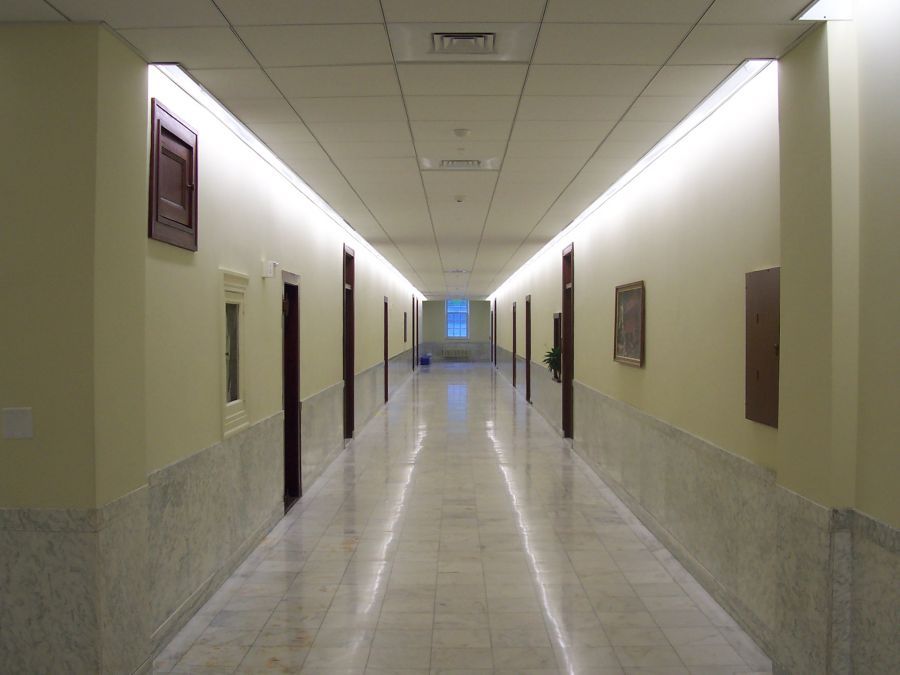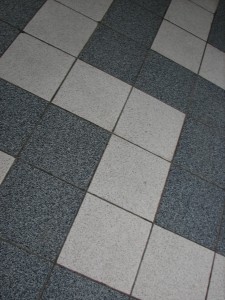Part 1: Why have your commercial buildings’ tile and grout professionally cleaned?
Walk into any commercial building in Denver, from a local coffee shop to the lobby of a multi-story building, and you will find a high-quality tile and grout floor. If you don’t see it in the front of the building,you will find itin the restroom. Why is this kind of flooring so popular?Tile flooring is highly desirable becausein comparison to carpet, it is more durable, easier for cleaning staff to maintain, and is, for the most part, more spot and spill resistant. These advantages all translate intocost savingsfor the maintenance budget.
During the recent Great Recession, manycommercial buildings stopped hiring outside contractors to do thorough tile and grout cleaning in an attempt to save money. Since dirty tile and grout can still seem presentable in a commercial setting, it was believed to be an easy way to eliminate asupposedly unnecessary service. This thinking has resulted in an epidemic of dirty commercial tile and grout and the contaminate-ladenindoor air associated with it. So why hire an outside contractor to clean tile and grout?
DIRTY TILE AND GROUT CREATES POOR INDOOR AIR QUALITY
If you have been in Denverfor any amount of time, you have seen the brown cloud hangingover the city on windless days. What many people don’t realize is thatsame pollution, along with fungus, bacteria, cigarette smoke, dust anddust mites all end up inside buildings and settle onto the floors, including tile and grout. Simply mopping will not remove all of the contaminants from tile and grout, and we will return to this subject in a minute.
Each time someone walks across a floor, contaminants are kicked up and circulate through the air again, to be breathed in by everyone in the area. After that, the contaminantsare redistributed throughout the room, settling downon furniture and furnishings in a relentless layer ofunsightly dust. Over time, the once air-borne contaminantsbecomeembedded in the porous surfaces of tile and grout.In these tiny shelters bacteria and fungus mix with dust and moisture, finding the nutrientsthey need to flourish and release spores into the air,causing further air contamination.
A thorough deep cleaning of tile and grout is a sure way to reduce the indoorair pollutants in any commercial building. It removes any particles that could be kicked up, as well as the sticky contaminants that nurture fungus and bacteria. This is especially true in public restrooms, whereeveryday issues that affectcommercial tile and grout are compounded with thecontaminantsand high moisture issuesparticular to restrooms. A thorough cleaning of tile and grout will remove the bacteria and fungus found in bathroom tile and grout, and will improve the smell of the room.
THE ONLY WAY TO CLEAN WITHOUT LEAVING RESIDUE AND CONTAMINANTS ON THE FLOOR IS THOROUGH RINSE AND EXTRACTION
Part of everyday cleaning for commercial buildings is to mop the hard floors. While this is a vital part of keeping the floors clean and improving the overall life of the tile and grout, it doesn’t effectively remove all of the dirt and contaminants from the floor. If you want to see a dramatic view of what is left behind from mopping, look in a commercial bathroom that has not had a professional cleaning in quite some time.

Look at the grout on the wall next to the floor, then compare the color of that grout to the color of the grout on the floor. They are the same original grout and should be the same color. But what you will see is a white or gray color grout on the wall, and probably a black grout on the floor. Why the difference? The dirt and contaminants on the floor are not removed by mopping alone. A thorough deep cleaning is needed to have a clean tile and grout floor.
WHAT KIND OF PROFESSIONAL CLEANING SHOULD I CHOOSE?
Some companies sell a “be your own boss” tile and grout cleaning system which utilizes a mop, mop bucket and grout brush. These tools are marketed to people who are trying to get started in the tile and grout cleaning business. These systems simply do not work because they don’t thoroughly rinse and remove dirty water fromthe tile and grout. No matter how industriously hand tools are employed, they will leave a dirty, sticky residue on your tile and grout, and in those little crevices sheltering bacteria and fungus.
The method we recommend is a 4-part cleaning system:
- Pre-treat areas with a quality emulsifier cleaning agent and a degreaser to release soils
- Scrub the treated areas with a brushed buffer to physically engage and break up those deep, hard-to-reach soils
- Thoroughly rinse with abundant hot water in a high pressure spinner tool, while simultaneously retrieving the water and the contaminants in it with a high-power vacuum.
- Seal the grout to prevent staining and damage.
This is just the surface of hard floor care. Now that stone floors and tiles are the commercial flooring of choice, special products and cleaning techniques are needed to provide thorough cleaning and protection for these surfaces as well. Part 2 of this blog will discuss caring for stone and stone tile floors.

